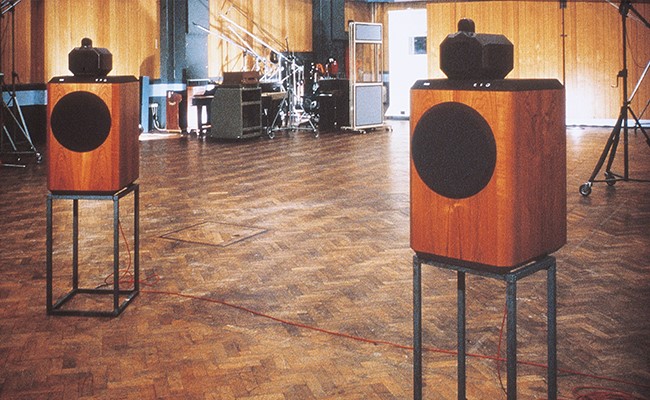Now this is definitely nonsense. The sound from a speaker cabinet should be inaudible so that it doesn't distort the sound coming from the drivers. The BBC "thin walls" approach as described in the paper cited earlier is a perfectly valid way of trying to achieve this. In fact the BBC performed listening studies as part of the work to make sure the resonances were just below the threshold of audibility. The chap you were talking to might have been an idiot but Spendor themselves are a good competent speaker company even if some in their range is targeted at enthusiasts for ye olde worlde products.What he said (I made a note) was that the that the speakers are “thin walled”, and are hence designed to vibrate and resonate with the music.
You are using an out of date browser. It may not display this or other websites correctly.
You should upgrade or use an alternative browser.
You should upgrade or use an alternative browser.
Ported or sealed box speakers. Which do you prefer?
- Thread starter lindsayt
- Start date
The problem with the LS3/5as (and similar mini-speakers) is that they aren't really suited for serious listening unless supported by subs.
I think the design goals were that they were to be practical for monitoring speech in small studios. They did that pretty well, and it was a bonus that they were better than expected (or quite possibly necessary) on music. The beeb used bigger speakers in fancier studios to balance music broadcasts. Also consistency was important. They weren’t kept in pairs, engineers expected any two pulled from a cupboard to be similar, hence the adjustments in the crossover. The designers of the LS3/5A were well aware of the low frequency limitations. They say in the paper I cited
“It should be evident from the shape of the curve in the bass that the low-frequency unit is overdamped**; therefore the bass response could be still further extended either by reducing the sensitivity or by the equivalent of feeding it, not from a constant voltage source, but from a source with an impedance of about seven ohms, and redesigning the equaliser/crossover network for the bass unit. The penalty in either case would be a significant loss of efficiency. The sound distribution is seen to be quite wide in terms of angle of radiation and to vary smoothly with angle. Listeners off axis should therefore still receive good sound quality.
The cabinet does not contribute significant colouration, and the non-linearity distortion is low over the whole frequency range.”
It was less the pod shape and more the crossing of a large midrange to a tweeter at a high frequency. This causes resonance throughout much of the midrange passband and significant off-axis issues which B&W partially compensate for by introducing significant peaks and valleys in the on-axis frequency response. It creates a characteristic sound but why do it? I am sure they have their reasons and I am curious about what they might be.Elipson looks like an interesting case study
[/MEDIA]
mandryka
pfm Member
The problem with the LS3/5as (and similar mini-speakers) is that they aren't really suited for serious listening unless supported by subs.
I suppose that depends on what you listen to and how closely you listen.
I’m listening right now pretty seriously to a solo lute recording on some speakers with bass drivers about 4 inches diameter, the speakers are a couple of metres away, it sound just fine. Think big headphones.
beammeup
pfm Member
Box-less like the ESL is best. IMHO. Mind you the ESL has the advantage of not having the inertia of conventional cones as well.
All boxes resonate, whether ported or closed.
ATB from George
Seems logical! ESL's have no box resonance issues and are faster with transients due to not having the inertia of conventional cones as you say - so why then don't all audiophile own the ESL (or similar like a Magnepan) if that's the better design type?
tuga
Legal Alien
I suppose that depends on what you listen to and how closely you listen.
I’m listening right now pretty seriously to a solo lute recording on some speakers with bass drivers about 4 inches diameter, the speakers are a couple of metres away, it sound just fine. Think big headphones.
"Just fine" is subjective, depends on who's listening.
Not really like big headphones since these are full range and don't have the dynamic restrictions. But I don't enjoy listening through headphones either.
The LS3/5as are probably fine for background but I wouldn't want a pair for serious listening. I find that even my LS3/6s could do with a bit more low end extension and a cleaner, crisper bass.
jtgofish
pfm Member
Interesting comments about ported speakers which use large woofers sounding better than those using smaller ones.I tend to agree but the main reason for that is that bigger woofers tend to sound much better regardless of what type of box loading they use.The big driver/onken style ported combination can ceratinly sound very decent.
I think the Yamaha NS 5000s which use a 12 inch woofer in a ported box have fantastic bass but they use a unique internal resonance damping device which tunes out unpleasant resonances.
I think the Yamaha NS 5000s which use a 12 inch woofer in a ported box have fantastic bass but they use a unique internal resonance damping device which tunes out unpleasant resonances.
Jonathan
pfm Member
Well I've never heard percussions sound as realistic as on my 'statics. I mean real percussions, not amplified ones.
Of course you don't get sheer level, but you get quality. I can live with that.
yes i've been thinking of going that way -or trying a set of the new magnepans at least ... my audio physics do amazing things for percussion but i'm looking for just that little bit more 'body' and 'presence' and dimensionality somehow. sheer volume isn't that important.
Jonathan
pfm Member
Really.
It should be the other way around because ports soften transients and produce latency in their operating bandwidth...
it's always seemed to me that ports give the driver a bit more freedom of movement where an infinite baffle forces the driver to just compress and decompress the enclosed air - kind of like having a compressor in your signal chain. but that's just as i imagine it to be the case. I tend to go for transmission line types typically - just about any loudspeaker I've ever really loved has been 'ported' in some way. But I'd love to hear the other side of the coin ...
Jonathan
pfm Member
Interesting comments about ported speakers which use large woofers sounding better than those using smaller ones.I tend to agree but the main reason for that is that bigger woofers tend to sound much better regardless of what type of box loading they use.The big driver/onken style ported combination can ceratinly sound very decent.
I think the Yamaha NS 5000s which use a 12 inch woofer in a ported box have fantastic bass but they use a unique internal resonance damping device which tunes out unpleasant resonances.
hmmm dunno - i've ALWAYS gravitated toward smaller drivers - like 5" ... might not have the VOLUME of bass but they certainly have the right 'thwap' ...
tuga
Legal Alien
it's always seemed to me that ports give the driver a bit more freedom of movement where an infinite baffle forces the driver to just compress and decompress the enclosed air - kind of like having a compressor in your signal chain. but that's just as i imagine it to be the case. I tend to go for transmission line types typically - just about any loudspeaker I've ever really loved has been 'ported' in some way. But I'd love to hear the other side of the coin ...
TLs are the worst offenders when it comes to latency in the lower frequencies (i.e. the delay between the higher-frequency attack transient and low frequency sustain of a timpani).
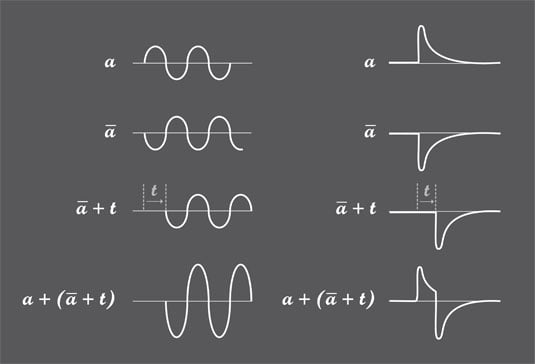
Transmission line speaker design debunked: On the left, a sine wave a leaves the front of the speaker. An inverted sine wave ā leaves the rear. Rear wave is delayed by transmission line to become ā + t. When this emerges from the transmission line it is in phase with a and adds up. On the right, a transient is applied instead. What comes from the speaker is unrecognisable because a time delay only looks like an inversion to a symmetrical and continuous signal. Unfortunately, most of the information in audio is in the transients.
But like many other distortions in audio it may sound euphonic (nice) to some people because it creates an effect that subjectively may create the illusion of a larger space, a bit like reverb.
A TL give even more low frequency extension than bass reflex but they're both really props or crutches, a bit like botox and silicone.
tuga
Legal Alien
hmmm dunno - i've ALWAYS gravitated toward smaller drivers - like 5" ... might not have the VOLUME of bass but they certainly have the right 'thwap' ...
A driver can produce low frequencies by having either a large cone surface area (in a large box) or a long-excursion suspension (in a smaller box).
If I'm not mistaken, and generally speaking, a small long-excursion woofer produces more harmonic distortion and more intermodulation distortion and compression at lower listening levels and is less sensitive.
The only reason for the existence of small long-woofers is the demand for small speakers. But you also need a big box to produce low frequencies hence the crutches (TL, bass-reflex) which have the welcome side effect of increasing sensitivity a little and easying the load.
My view is that sound should be produced by a driver and fitness for purpose is the key here: tiny tweeters, mid-sized squawkers and large woofers...and sub-woofers for sub-bass.
This image was taken from a vintage Kef user manual:
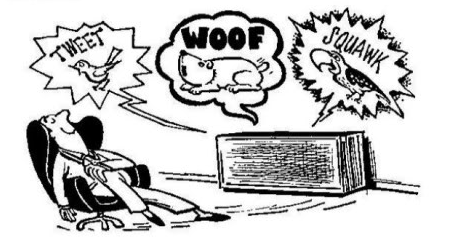
P.S.: dividing the spectrum over different dedicated drivers or ways reduces intermodulation distortion and ensures that each driver is operating within it's optimal range (avoiding nasty break-up resonances and the need for complex notch-filter with the bonus of a smoother off-axis response).
I'd say that the sweet-spot is a 3-way speaker though one would really need 4 ways (and a large) to accurately cover the whole 20Hz to 20kHz audible spectrum.
tuga
Legal Alien
It was less the pod shape and more the crossing of a large midrange to a tweeter at a high frequency. This causes resonance throughout much of the midrange passband and significant off-axis issues which B&W partially compensate for by introducing significant peaks and valleys in the on-axis frequency response. It creates a characteristic sound but why do it? I am sure they have their reasons and I am curious about what they might be.
The early Matrix models had an impecable off-axis behaviour perhaps because they used a smaller 5" midrange and steep filter slopes:
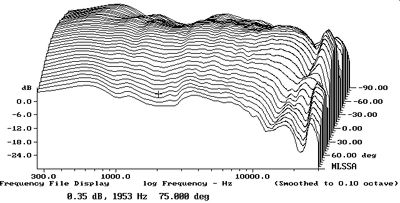
B&W Matrix 801, lateral response family at 50", from back to front:
responses 90 degrees-5 degrees off-axis, reference response on tweeter axis,
responses 5 degrees-90 degrees off-axis.
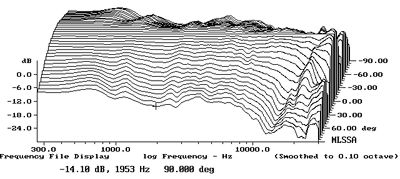
B&W Matrix 801, lateral response family at 50", from back to front:
differences in response 90 degrees-5 degrees off-axis, reference response on tweeter axis,
differences in response 5 degrees-90 degrees off-axis.
Read more at https://www.stereophile.com/content/bw-matrix-801-series-2-loudspeaker-measurements
I had a pair of 802 S3s for a while, not that long ago actually, but they made my ears bleed (hard cones and domes?) so I ditched them.
The early Matrix models had an impecable off-axis behaviour perhaps because they used a smaller 5" midrange and steep filter slopes:
There seemed to be a change in approach in the 90s away from speakers for engineers towards speakers for audiophiles. It is the story behind this that I would find interesting. There is no question that relevant engineering knowledge is high at companies like B&W (unlike some boutique audiophile companies) and so when they do apparently odd things w.r.t. engineering it will be for reasons they both understand and consider a positive contribution to their objectives.
The 6" cone is kevlar which is soft and well damped not hard with little damping. A typical hard 6" cone crossed at 4kHz would quite literally be unlistenable because of the strength of the resonant motion. A significant amount of high loss material would almost certainly need to be attached to the cone in some way if this was to be contemplated.I had a pair of 802 S3s for a while, not that long ago actually, but they made my ears bleed (hard cones and domes?) so I ditched them.
The tweeter dome is hard but we don't hear ultrasonic (linear) resonances despite the imagination of many audiophile. What we do hear is a significantly different radiation pattern from largely pistonic hard domes and resonating/flapping soft domes. Which is preferable will be influenced by the shape of the baffle or waveguide and the objectives for the tweeter.
This speaker (or at least the 802D version in stereophile) does exhibit the odd midrange/tweeter behaviour I commented on earlier.
John Phillips
pfm Member
I have seen and followed a lot of significant engineering development over the 40 or so years I have been interested in audio. Most of that has been to get products to approach closely the "normal" standards of engineering quality. And a lot of modern products really do get much closer than they used to.There seemed to be a change in approach in the 90s away from speakers for engineers towards speakers for audiophiles. It is the story behind this that I would find interesting. There is no question that relevant engineering knowledge is high at companies like B&W (unlike some boutique audiophile companies) and so when they do apparently odd things w.r.t. engineering it will be for reasons they both understand and consider a positive contribution to their objectives. …
However like you what I have also seen much of recently is that product differentiation seems to be increasing in popularity as an alternative. Presumably because customers like it and the products sell. For example, from the 2013 Stereophile review of the B&W 804d (my emphasis):
"In 2004, I visited Bowers & Wilkins' Research Center, in the village of Steyning, West Sussex, nestling in the shadow of England's South Downs, north of Worthing. I was impressed by both the depth and the breadth of the engineering talent and resources I found there. There is no doubt in my mind that B&W's engineers can design a loudspeaker to have any response they desire. That the 804 Diamond does not have a flat on-axis response is thus a mystery. That suckout in the presence region in fig.4, for example, appears from fig.5 to be due to the large-diameter midrange driver narrowing its radiation pattern in the top octave of its passband, despite the FST technology that is intended to prevent that from happening. But overall, the B&W 804 Diamond's measured performance is quite respectable.—John Atkinson"
If that's what many customers like then there's no argument from me, although experience tells me that my ears still generally prefer good engineering quality.
tuga
Legal Alien
The tweeter dome is hard but we don't hear ultrasonic (linear) resonances despite the imagination of many audiophile. What we do hear is a significantly different radiation pattern from largely pistonic hard domes and resonating/flapping soft domes. Which is preferable will be influenced by the shape of the baffle or waveguide and the objectives for the tweeter.
I will not contest the wide imagination of many audiophiles but some sources (i.e. John Atkinson, Jussi Laako) defend that tweeter resonance will produce sympathetic harmonic distortion which may creep into the audible range like the fold-back aliasing in digital audio.
Current Diamond tweeters start breaking up at a much higher frequency.
Regarding BnW's kevlar cone, JA discusses break-up resonances here.
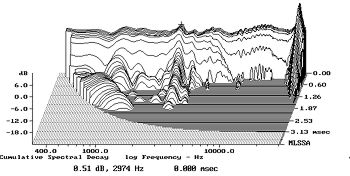
The waterfall plot calculated from the impulse response is shown in fig.13.
A superbly clean decay overall is undoubtedly associated with the speaker's refined sound.
Note, however, the ridge parallel to the time axis associated with the on-axis peak at 3kHz.
Here's that pesky woofer-cone mode again.
George J
Herefordshire member
Seems logical! ESL's have no box resonance issues and are faster with transients due to not having the inertia of conventional cones as you say - so why then don't all audiophile own the ESL (or similar like a Magnepan) if that's the better design type?
ESLs have compromises too! To make a small one that works near full frequency is impossible because of the laws of physics. Even the original 1957 ESL is not exactly a bass monster though the bass remains lucid and in good balance. It is rather a large speaker.
So later ESLs became even larger to allow for more deep bass in the balance, and then put two of them into a normal sized room and they dominate.
I guess that has a good deal to do with why the ESL is still a minority choice. But the 1957 ESL stayed in production for a very long time, and there were a huge number made over the time. I may be wrong, but as I remember it something like 30,000 pairs made. I bet that puts many high end speaker model production runs in the shade!
Best wishes from George
PS: My single ESL has a serial number in the 1,800s so a very early example indeed. It was produced in the era before stereo was a big thing and so both input terminals are black rather than the normal black and red on the speakers sold in stereo pairs to allow for easy connection in correct phase coherence between the channels.
moo-fi
pfm Member
The maths quoted in Tuga's post is and I am being generous, horribly flawed. Transmission line theory is rather complex and generally involves calculating lots of changes of rates of both voltages and frequency and not the simple equation given.
While I am not PMC's biggest fan, if they where as bad as has been suggested they certainly wouldn't appear in as many studio's as they do.
While I am not PMC's biggest fan, if they where as bad as has been suggested they certainly wouldn't appear in as many studio's as they do.


